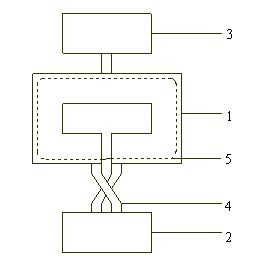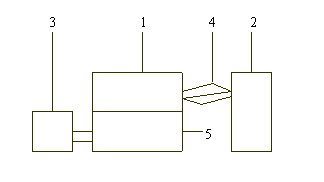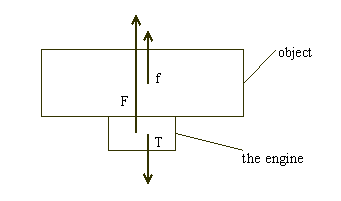Chapter 4: The utility of my device - Applying superconductivityiOLD VERSIONj
Section 1
My invention
As for my equipment, the usefulness for industries is very high. You can use the force to cause the anomaly of the weight on my device. You can use repulsion or attraction between the loop of the electric current and the superconductive magnet. You can use this force as propulsive force, flotage and braking power. If changing the cable fixed on the superconductive magnet into tough metal with little electric resistance, the consumption of electric power can be held even if you pass a strong electric current to get big propulsive force. Since the ripple current is strong and moreover has low electric power consumption, it has low voltage and doesn't have a bad influence on the superconductive magnet. Also, you can make the metal convey the propulsive force to the frame of vehicles. You cover the metallic normal-conductor with the tough material which doesn't hamper magnetic force and prevents the electric current from leaking out. I drew the shape of my invention in the figure 5 and 6. I named this invention "superconductive electromagnetic engine" and applied for the patent. If you change the strength of the magnetic field of the superconductive magnet or the strength of the ripple current or the size of the superconductive magnet and the cable, you can get propulsive forces of various strength. Also, by combining more than one electromagnetic engine, you can get stronger propulsive force. If fixing more than one electromagnetic engine on the frame of vehicles and control them electronically, you can freely move the vehicles in the air. The super conductive electromagnetic engine can make all vehicles highly more effective. You can make floating platform to load with. By using them you can easily move with things. You can rotate very huge objects. You can think about applying it to power generation, too.
[ Figure 5 ]
A floor plan from above to see a superconductive electromagnetic engine

[ Figure 6 ]
A side view which shows a superconductive electromagnetic engine

[ Explanation of the mark ]
1: normal conductor
2: ripple current power supply
3: refrigerator
4: cable
5: superconductive magnet
Section 2
The use of the electromagnetic engine
The engines are fixed to a frame of a vehicle, the driving forces of the engines are conveyed to the vehicle and move the vehicle. For an example, a figure which says an object to be launched by the electromagnetic engine was shown. An electromagnetic engine touches the bottom of the object and is fixed to it. It is supposed the force of the electromagnetic engine is F and that the force which is given to the object by the electromagnetic engine is f. The electromagnetic engine receives drag T as the reaction against the action which gives the force f to the object. It is supposed that the force to act on this whole equipment by the electromagnetic engine is P.
P=F+f-T

By the law of action and reaction
f=T
Then
f-T=0
Substituting P for this
P=F+f-T=F+0=F
After all, the force P to act on the whole equipment becomes F.
When this F is bigger than the gravity which acts on the mass of the whole equipment, this equipment can be launched above.
Section 3
Applied superconductivity technology and my theory
There is an idea, the superconductive electromagnetic propulsion ship which uses the reaction of electromagnetic force. This belongs to applied superconductivity technology. It is said the ship goes ahead as follows. They run an electric current through water. They put water in a magnetic field made by a super conductive magnet fixed to the ship. Then electromagnetic force on the basis of Fleming's left-hand rule arises. The electromagnetic force pushes water out. By the reaction of pushing out, the ship goes ahead. However, actually, the cable for passing the electric current through salt water directly get the force from the magnetic field made by the superconductive magnet and convey the force to the ship's body as propulsive force.rom "The Science of Electromagnetic Propulsion by Superconductivity" by IWATA Akira and SAZI Yoshiro, published by Asakura Shoten).
As they get the propulsive force not from the superconductive magnet but from the normal conducting cable, it doesn't contradict my theory of neutralizing restrictively electromagnetic force in superconductive magnets at all.
Also, there are arms called rail guns in the idea of using the superconductive magnet and Fleming's left-hand rule. I think that the electromagnetic force acting on the superconductive magnet of this rail guns by unstable magnetic fields may be neutralized. However, I think, as the fact that there are little reaction as the gun by this is a good thing and doesn't make a problem at all, they never notice the nature of superconductive magnets, the neutralization of electromagnetic force. I think, as in the other similar technology applying superconductive magnets little reaction doesn't make a problem, they don't notice the nature of superconductive magnets of neutralizing restrictively electromagnetic force, too.
The linear motorcar of Japan Railways also belongs to applied superconductivity technology. The linear motorcar runs alternating currents through its propulsion coils. It could be thought that unstable magnetic fields had occurred with it.
"The forces which each coil creates changes every time the superconductive magnets of the trains pass through, they change drastically, but they are combined at each superconductive coils and the change becomes small there."
(" Technology of the Magnetic Levitated Train" by SHODA Eisuke and others, page 69, published by Ohm Inc.)
Stable magnetic fields, the magnetic fields that have temporally little change act on the superconductive magnets and the propulsive force arises. Also this thing can be confirmed by the fact that the linear motorcar does very stable running.